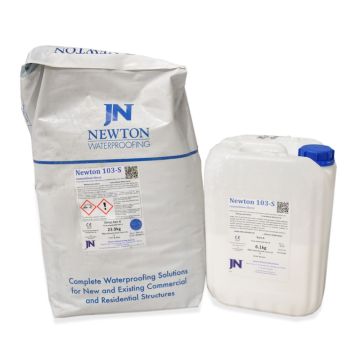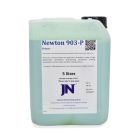Newton HydroCoat 103 2K - Liquid Waterproofing Membrane 30kg
A high adhesion Liquid Waterproofing Membrane that can resist both extremely high positive and negative water pressure.
High Adhesion Liquid Waterproofing Membrane
Newton HydroCoat 103 2K is a two-component, cementitious waterproofing membrane. It is designed for the internal and external waterproofing of water-retaining / water-resisting structures such as reservoirs, water tanks, below ground structures, podium decks, and parking areas.
This cementitious waterproofing membrane is capable of resisting extremely high positive and negative water pressure. When it dries, Newton HydroCoat 103 2K is hard wearing and provides enhanced chemical resistance, suited for protecting concrete within sulphate-contaminated ground.
Uses of Newton HydroCoat 103 2K
The Newton HydroCoat 103 2K waterproofing membrane can be used on concrete and steel elements in the following situations:
- Reservoirs & water tanks
- Podium decks, balconies, and car parking areas
- Concrete water-retaining structures such as water tanks and reservoirs
- Concrete earth-retaining foundation walls to both the positive and negative side
- Internal concrete surfaces of walls and rafts or slabs to earth-retained structures such as habitable basements, car parks, plant rooms and lift-pits
- Concrete temporary lay down and working areas
Applying HydroCoat 103 2K Liquid Waterproofing Membrane
Newton HydroCoat 103 2K cementitious waterproofing membrane is easy to apply. Exact methods depend on specific application and substrate. For full details please refer to the product data sheet before installation.
PREPARATION - Ensure all surfaces are structurally stable, clean, dry and free from any oils, paints, agents. Remove laitance from new concrete floors. Any damage or faults will need to be repaired prior to membrane application.
PRIMING - varies depending on application - refer to data sheet.
MIXING - Shake the ‘Part A’ bottle thoroughly and pour into a clean mixing vessel. Add the powder - ‘Part B’ - slowly whilst mixing continuously and slowly. Mix together for 5 minutes until you achieve a smooth product, with as little air as possible. Remember to regularly scrape sides to avoid any lumps forming and to ensure that both components are fully mixed. Mix for a minimum of 5 minutes and use without any delay due to the chemical reaction beginning.
APPLICATION - Newton HydroCoat 103 2K is very quick and easy to apply with an airless spray machine on horizontal surfaces. The mixed slurry can also be applied by brush, Squeegee, Roller, Trowel or Pin Leveller. Ensure that air is not entrapped into the surface of horizontal applications by using a spiked roller as soon as the product is placed.
Important note: As soon as the two parts are mixed, a chemical reaction begins. You have a pot life of 30 minutes at 20ºC. You must use it before it starts to go off and over thicken. Do not apply at temperatures lower than +5°C or higher than +30°C
If you need to reinforce and cover joints, use Newton HydroCoat 912-RT.
Permagard - Providing Solutions. Inspiring Confidence
Permagard are proud to stock a wide range of Newton membranes and waterproofing products. If you have any questions about Newton liquid waterproofing membranes or cementitious tanking in general please contact our expert team on 0117 982 3282.
Features
- Extremely waterproof - resistant to 10 bar positive and negative pressure
- Quick and easy to apply to horizontal surfaces
- Non-toxic when cured
- Hard, durable and UV-stable trafficable finish
- All year round application to damp substrates
- Can be applied at temperatures as low as 5°C
- Very low VOC content
- Very high diffusion resistance to carbon dioxide gas and chloride ions; equivalent to 100 mm of concrete cover
- Excellent adhesion to sound prepared concrete substrates and steel
- Thixotropic - can be applied at 1 mm to vertical surfaces
- High build coating of 2 mm eliminates the incidence of small defects seen within thinner membranes



